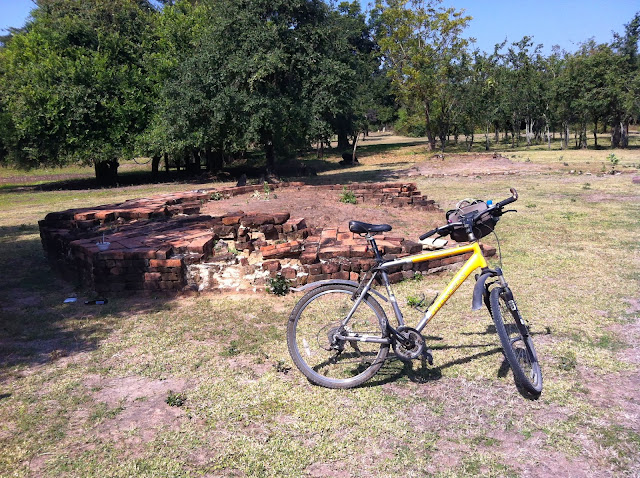Not much archaeology has been done at this ancient site. The presumption is that the original city of Sema (which is probably not the original name) was built by Mon speaking Buddhists and was part of the Dvaravati civilization which covered much of modern day Thailand and lasted from about the 6th century through the 13th century. By the 10th century the Khmer Empire started to move into northeast Thailand from what is present day Cambodia. The circular moats shown above were probably built by the original Mon speakers while the rectangular moat is probably Khmer. All of the monuments pictured below are Khmer.
This monument is located just outside the southeast corner of the rectangular moat.
It was built from fired clay brick.
Southwest corner of the rectangular moat.
Monuments Within the Small Circular Moat
12th century Khmer monument. There was a central structure and several outbuildings surrounded by a wall. Construction is sandstone and clay brick.
Sema Stones are leaf-shaped stones which mark the sacred boundary of a Buddhist Ordination Hall or Ubosot. The Sema Stones in the foreground indicate that the structure behind was built as an Ubosot.
Sema Stones in the lower left.
These women walked through the historic site. They told me they were hunting field crabs. I followed them into the jungle to this pond where they used loosely woven baskets to scoop crabs up from the bottom.
The structure behind the bicycle is an octagonal chedi (stupa) made entirely of brick.
Sema Stones indicate that this was built as an Ubosot.
Part of the circular moat, built well over a thousand years ago, still holds water.
Reclining Buddha at Wat Dharmacakra Semaram
This reclining Buddha image is on the grounds of Wat Dharmacakra Semaram, also known as Wat Phra Non. The image, made of many blocks of red sandstone, probably dates from the 8th century. It is possibly the oldest reclining Buddha image in Thailand.
It's hard to get a good photo of the entire Buddha image because the structure built to support it is rather confining.
The Dharmacakra stone (Wheel of Life) in the plastic case is the original from the 8th century. In front is a modern replica.
Lots and lots of hay….
Ancient Korat
Prasat Muang Khaek
A large Khmer style temple with a moat, colonnaded wall and two walled chedi.
One of the chedi.
Prasat Non Ku
10th century Khmer
Prasat Muang Kao
Prasat Muang Kao is one of about 120 way stations built by the Khmer between Angkor Wat and northeast Thailand in the 11th and 12th centuries. It's made of sandstone and laterite stone. It has a nice stone-lined pond.
Stone lined pond.
Reconstructed lotus blossom decoration which was probably on the roof of the structure.
The main structure is sandstone.
This separate building is made of laterite stone.
The Khmer never used true arches, instead they used the corbel arch as seen here.































An excellent page about a part of Thailand most people will never experience.
ReplyDeleteThanks for your kind words.
Delete